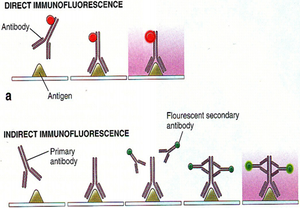Immunohistochemical methods, principles and application
A highly specific interaction occurs between molecules known as an antigen and its corresponding antibody, a method that proves useful in identifying and localizing numerous specific proteins. The body's immune cells possess the ability to distinguish between its own molecules and foreign substances (antigens). Upon exposure to an antigen, the body generates antibodies that react specifically and bind to the antigen.
Antibodies can be labeled through coupling with various compounds:
1. Fluorescent compounds - for examination under a fluorescence microscope.
2. Enzymes such as peroxidase or alkaline phosphatase - for detection using histochemical methods.
3. Gold particles and ferritin.
Direct method[edit | edit source]
An antibody produced against the tissue protein of interest is directly tagged with a label, such as a fluorescent compound or peroxidase. When applied to a tissue section on a slide, these labeled antibodies bind specifically to the protein (antigen) against which they were generated and can be visualized using the appropriate method.
Indirect immunocytochemistry[edit | edit source]
It involves initially incubating a tissue section believed to contain protein X with a mouse anti-X antibody. After washing, the tissue sections are then incubated with labeled rabbit or goat antibodies against mouse antibodies. These secondary antibodies recognize the mouse antibody that targeted protein X. As more than one labeled secondary antibody can bind to each primary antibody molecule, the labeling of the protein of interest is amplified through the indirect method.
References[edit | edit source]
- JUNQUIERA, Anthony – MESCHER,. Junqueira's Basic Histology. 16. edition. McGraw Hill LLC, 2001. 576 pp. ISBN 1260462978.

